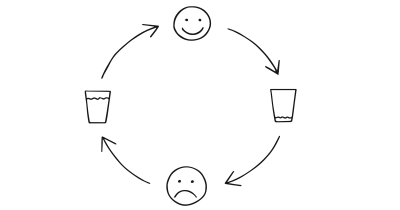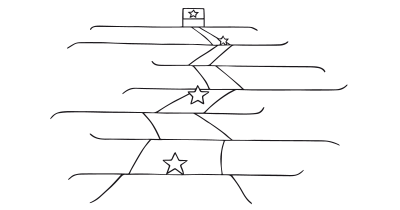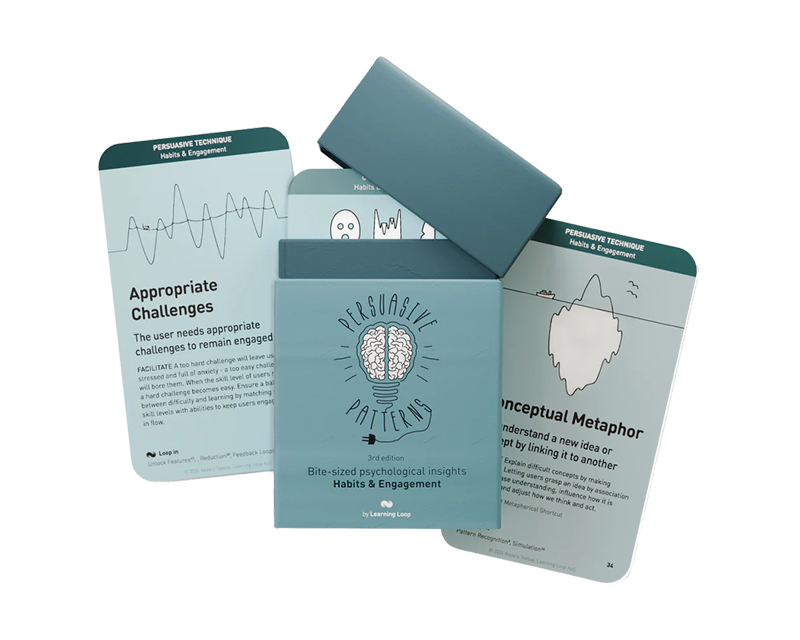Persuasive Patterns: Facilitation
Appropriate Challenges
The user needs appropriate challenges to remain engaged

Appropriate Challenges refer to the practice of systematically adjusting the difficulty of tasks to match the evolving skills of the user, aiming to maintain a state of engagement and motivation.
The concept is rooted in the psychological theory of flow, developed by Mihaly Csikszentmihalyi. This theory suggests that individuals are most engaged when they are involved in an activity that is neither too difficult nor too easy relative to their current abilities.
The primary goal of implementing Appropriate Challenges is to sustain user engagement and optimize their experience by continuously adapting challenges to their growing skill set. This helps in maintaining a balance where the user does not feel overwhelmed or bored, but rather, remains in a state conducive to optimal performance and satisfaction.
In a classroom setting the teacher introduces basic problems that match the students’ current understanding. As students grasp these foundational elements, the teacher progressively introduces more complex problems. This method keeps the students engaged, as each new problem provides just the right level of challenge to keep them interested without causing frustration or disinterest. The success of this teaching method lies in the teacher’s ability to gauge the collective skill level of the class and adjust the challenges accordingly.
Bridging from the educational scenario, consider a language learning app that employs a similar strategy. Users start with simple vocabulary and basic sentences. As their proficiency improves, the app introduces more complex grammar and richer vocabulary. Just like the teacher who assesses the students’ readiness for more challenging material, the app uses algorithms to adjust the difficulty based on the user’s performance on previous lessons. This keeps the learning process engaging and effective, encouraging users to continue using the app over time.
The study
One of the most influential studies in understanding the power of the “Appropriate Challenges” pattern is Mihaly Csikszentmihalyi’s exploration of the flow state. His research examined how individuals experience deep engagement in activities that precisely match their skills to the challenges presented. By studying artists who lost track of time while working on their art, Csikszentmihalyi discovered that when a task’s demands are aligned with one’s ability, it creates an optimal state of intrinsic motivation and focus, termed as “flow.” This state not only enhances productivity and creativity but also contributes to overall happiness and satisfaction.
Csikszentmihalyi, M. (1990). Flow: The Psychology of Optimal Experience. New York: Harper & Row.
The concept of flow and the principle of appropriate challenges were developed by Mihaly Csikszentmihalyi in the 1960s and 1970s. His interest in human happiness and what makes life worth living led him to identify and articulate the dynamics of the flow experience. The idea gained traction in various fields, influencing educational practices, business management, and design thinking.
Flow describes a state of deep absorption and engagement in activities where an individual’s skill level is perfectly matched to the challenge they face. This balance prevents feelings of boredom when a task is too easy and anxiety when it is too difficult.
Flow is achieved when activities provide a clear set of goals, require specific responses, and offer immediate feedback. This alignment allows individuals to lose self-consciousness and time awareness, focusing entirely on the task at hand. This principle has been widely recognized for its contribution to enhancing performance, improving learning outcomes, and increasing intrinsic motivation.
Csikszentmihalyi’s work shows that inducing flow can lead to peak experiences, which are moments of high creativity and fulfillment. These moments are essential for personal development and well-being, making the application of “Appropriate Challenges” vital in environments aimed at fostering growth, such as in education, workplace training, and user interface design. By utilizing challenges that are specifically tailored to an individual’s capabilities, designers and educators can effectively harness the motivational power of the flow state.
The Flow Channel and Appropriate Challenges
The “flow channel” is a concept that visualizes how the relationship between the challenges of a task and an individual’s skill level can create the state of flow. This model is crucial for understanding how to implement “Appropriate Challenges” effectively.
The Flow Channel Model
The flow channel is depicted as a corridor or zone that runs diagonally between the axes of challenge and skill in a two-dimensional graph. On this graph:
- The vertical axis represents the level of challenge of a task.
- The horizontal axis represents the skill level of the individual performing the task.

The flow channel itself is the area where the challenge of a task is proportional to the skill level of the individual. When both the challenge and the skill level are high, the individual experiences flow, characterized by engagement and focused motivation. This state is optimal for performance and learning, as it promotes both efficiency and growth.
If the task’s challenge level falls below the individual’s skill level, the person may experience boredom due to the lack of stimulation. This area lies below the flow channel, where tasks are too easy relative to the person’s capabilities.
Conversely, if the challenge exceeds the individual’s skill level, it can lead to anxiety and frustration. This area lies above the flow channel, where tasks are too difficult, overwhelming the individual’s current abilities.
This balance is dynamic, requiring continuous adjustment as an individual’s skills develop. The goal is to keep tasks within the flow channel to sustain engagement and facilitate continuous improvement.
In practical terms, this might involve gradually increasing the difficulty of tasks as a person masters each level, ensuring that they are constantly challenged without being overwhelmed. This approach can be seen in educational curriculums, video game design, and software product design, and even in personal development plans.
Designing products through Appropriate Challenges
When designing a product its is often useful to start by developing a clear model of your user’s typical skill progression, which involves understanding the initial skill level and predicting how it might improve with interaction. Utilize user data to inform these predictions and ensure that the product’s challenges are always optimally aligned with the user’s current capabilities.
If you have your customer or user journey mapped, consider adding a layer that maps the user’s skill level (and its progression) in contrast with the skill level required at each step. Incorporate challenges at strategic points where they can enhance engagement without causing frustration.
To maintain user engagement, challenges should neither be too easy nor too hard. This balance is where the concept of the Flow Channel becomes crucial. The Flow Channel represents the ideal state where the challenges exactly match the user’s skill level, maximizing both satisfaction and productivity. Monitoring user interactions and feedback provides valuable data to adjust the challenges continually.
Keep the user in the Flow Channel
Map out the user’s journey through the product from initial engagement to advanced usage. Visual tools such as user flow diagrams can help identify where users might struggle or lose interest. Adjust the design to introduce new challenges at points where users are likely to have gained sufficient skill.
For software and games, incorporate algorithms that can automatically adjust the difficulty of tasks based on real-time user performance metrics. This ensures that the user remains in the Flow Channel, consistently challenged without being overwhelmed.
Keep the user in the Flow Channel by continuously providing context-sensitive feedback that lets users know how they are doing and what they need to adjust. This feedback can be in the form of progress bars, user stats, or personalized messages that encourage and guide the user.
Introduce complexity in increments that are perceivable but not daunting. For instance, if your product is a software tool, you might unlock advanced features as users demonstrate proficiency with basic features, thereby keeping experienced users engaged without alienating new users.
One common mistake is setting challenges that are too steep, too soon. This can alienate users who may not have the confidence or the immediate capability to meet these challenges. Another error is not providing sufficient feedback, which is crucial for users to understand how they are progressing and what is expected of them. It’s also important to avoid one-size-fits-all challenges, as user abilities can vary widely even within the same user segment.
Ethical recommendations
One primary ethical concern of designing for Appropriate Challenges is when this pattern is used to manipulate users into spending more time or money than intended, commonly seen in some gaming and e-commerce platforms. For instance, games might employ increasingly difficult challenges that nudge players toward in-app purchases to progress. Similarly, online learning platforms could continuously adjust challenges, leading users to perpetually engage without realizing substantial time investment, possibly at the expense of other important activities. These scenarios illustrate how unethical application can lead to addiction-like behaviors or unbalanced lifestyles.
There are several things you can consider to ensure that you follow an ethical approach to applying Appropriate Challenges:
- Be Transparent
Designers should be transparent about the mechanics and intentions behind the challenges presented within their platforms. This includes clear communication about what users can expect in terms of difficulty progression and any associated costs or time commitments. - Provide autonomy
Incorporating user control into the experience is vital. Users should have the ability to set and adjust the level of challenge they feel comfortable with, providing a way to opt out or modify their experience according to personal preferences or time constraints. This empowerment helps prevent feelings of frustration or entrapment. - Review the impact of your challenges regularly
Assess the impact on users of the challenges you have designed, ensuring that they contribute positively to user experience without causing undue stress or promoting unhealthy behaviors. This could involve collecting feedback from users about their experiences and making adjustments based on that input.
Real life Appropriate Challenges examples
Duolingo
This language learning app excels at adjusting difficulties based on user performance, ensuring learners remain in the flow channel by continuously offering new challenges that match their evolving language skills.
Adobe Photoshop
The photo editing software offers a tiered learning approach where new tools and features are introduced as the user’s ability to manage more complex tasks grows.
Fitbit
In fitness technology, Fitbit encourages users to progressively increase their activity goals based on past performance, keeping physical challenges in line with individual fitness levels.
Trigger Questions
- How well do we understand the skills and progression of our users?
- Are we providing challenges that are too easy or too hard for our users?
- Do our challenges dynamically adapt based on individual user feedback and behavior?
- Are we offering clear, immediate feedback to keep users informed of their progress?
- Have we considered the emotional impact of increased challenges on our users?
- How can we better personalize the challenge level for different segments of our user base?
Pairings
Appropriate Challenges + Feedback Loops
Combining Appropriate Challenges with Feedback Loops ensures that users not only receive challenges that are suited to their skill levels but also get continuous feedback on their performance. This can enhance learning and motivation, as seen in educational platforms like Khan Academy. Feedback loops work best when they are immediate, clear, and constructive. This helps users understand how they can improve and what exactly is needed to meet the next set of challenges.

The user needs appropriate challenges to remain engaged

We are influenced by information that provides clarity on our actions
Appropriate Challenges + Goal-Gradient Effect
Pairing with the Goal-Gradient Effect, where users are more motivated as they perceive themselves getting closer to a goal, can increase engagement. Fitness apps like Fitbit utilize this by showing progress bars and celebrating milestones, which work well with escalating challenges.

The user needs appropriate challenges to remain engaged

Our motivation increases as we move closer to a goal
Appropriate Challenges + Unlock Features
This pattern works well with Appropriate Challenges by unlocking new features or content as users master current levels. This approach is common in video game design, where players unlock advanced levels or abilities by completing easier stages, thus maintaining engagement and providing a sense of achievement. Ensure there are sufficient support mechanisms such as tutorials, hints, or help features so that the user knows how to get started with the unlocked feature.

The user needs appropriate challenges to remain engaged

Reward specific behaviors by enabling new capabilities
Appropriate Challenges + Rewards + Achievements
Integrating with Rewards and Achievements can make the experience more rewarding. Users receive tangible rewards or badges for overcoming challenges, which can significantly boost motivation and commitment, as seen in apps like Duolingo. Be sure to align rewards closely with the level of challenge and that the rewards scale with the difficulty to maintain a sense of fairness and motivation.

The user needs appropriate challenges to remain engaged

Use rewards to encourage continuation of wanted behavior

We are engaged by activities in which meaningful achievements are recognized
Appropriate Challenges + Tunneling
Guiding users through a predefined sequence of actions (Tunneling) can be enhanced by incorporating Appropriate Challenges at each step to ensure users remain engaged and do not feel overwhelmed by too many choices or complex functionalities too soon.

The user needs appropriate challenges to remain engaged

Close off detours from a committed journey
A brainstorming tool packed with tactics from psychology that will help you build lasting habits, facilitate behavioral commitment, build lasting habits, and understand the human mind. It is presented in a manner easily referenced and used as a brainstorming tool.
Get your deck!- Flow (psychology) at Wikipedia (en)
- Mihaly Csikszentmihalyi at Association for Psychological Science - APS
- Flow Theory in Psychology: 13 Key Findings & Examples by Kori D. Miller at PositivePsychology.com
- Csikszentmihalyi, M. (1975). Beyond Boredom and Anxiety: Experiencing Flow in Work and Play. San Francisco, CA: Jossey-Bass.
- Csikszentmihalyi, M. (1990). Flow: The Psychology of Optimal Experience. New York: Harper & Row.
- Nakamura, J., & Csikszentmihalyi, M. (2001). Flow Theory and Research. In C. R. Snyder & S. J. Lopez (Eds.), Handbook of Positive Psychology (pp. 195-206). Oxford University Press. This study elaborates on the concept of flow and its implications for achieving peak personal performance.
- Csikszentmihalyi, M., & Csikszentmihalyi, I. S. (Eds.). (1988). Optimal experience: Psychological studies of flow in consciousness. Cambridge University Press. This collection of studies provides a broad overview of the conditions under which flow occurs across different activities and populations.
- Csikszentmihalyi, M., Abuhamdeh, S., & Nakamura, J. (2005). Flow. In A. Elliot & C. Dweck (Eds.), Handbook of Competence and Motivation (pp. 598-608). New York, NY: Guilford Press.
- Moneta, G. B., & Csikszentmihalyi, M. (1996). The effect of perceived challenges and skills on the quality of subjective experience. Journal of Personality, 64(2), 275-310.
- Schaffer, O. (2013). Crafting fun user experiences: A method to facilitate flow. Human-Computer Interaction, 28(5), 358-389.
- Engeser, S., & Rheinberg, F. (2008). Flow, performance and moderators of challenge-skill balance. Motivation and Emotion, 32(3), 158-172.
- Keller, J., & Bless, H. (2008). Flow and regulatory compatibility: An experimental approach to the flow model of intrinsic motivation. Personality and Social Psychology Bulletin, 34(2), 196-209.
- Abuhamdeh, S., & Csikszentmihalyi, M. (2012). The importance of challenge for the enjoyment of intrinsically motivated, goal-directed activities. Personality and Social Psychology Bulletin, 38(3), 317-330.
- Self-Determination THeory by Anders Toxboe
